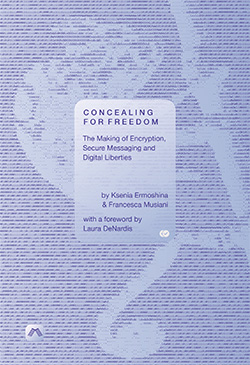Concealing for Freedom
By Francesca Musiani and Ksenia Ermoshina
Concealing for Freedom: The Making of Encryption, Secure Messaging and Digital Liberties sets out to explore one of the core battlegrounds of Internet governance: the encryption of online communications. Current debates around encryption have fundamental implications for our individual liberties and collective presence on the Internet. Encryption of communications at scale and in increasingly usable ways has become a matter of public concern, especially since Edward Snowden’s 2013 revelations. A new cryptographic imaginary is taking hold, which sees encryption as a necessary precondition for the formation of networked publics. At the same time, there have been major evolutions and accelerations in the field of secure communications, prompted in part by the cryptography community’s renewed efforts to create next-generation secure messaging protocols and applications.
It is vital that we unveil the very recent, and sometimes less recent history of these protocols and their key applications. The book takes on this task, in order to show how the opportunities and constraints they provide to Internet users came about, and how both developer communities and institutions are working towards making them available for the largest possible audience. It explores how efforts towards this goal are built upon interwoven stories about technical development and architectural choices, about community-building – and about Internet governance and politics. In doing so, the book focuses on the experience of encryption in a wide variety of contemporary secure messaging protocols and tools, and looks at the implications of these endeavors for the “making of” digital liberties on the Internet.
Concealing for Freedom provides two key empirical and theoretical contributions. Firstly, it enriches a social sciences-informed understanding of encryption. It does so by examining how different solutions of cryptography for secure communications are created, developed, enacted and governed, and what this diverse experience of encryption, operating across many different sites, means for online civil liberties. Secondly, it contributes to understanding the social and political implications of particular design choices when it comes to the technical architecture of digital networks, in particular their degree of (de-)centralization. The book explores developers’ actions and their interactions with other stakeholders, for instance users, security trainers, standardising bodies, and funding organizations. It also examines their interactions with the technical artifacts they develop, in which a core common objective is to create tools that “conceal for freedom” even as how this objective is met differs according to technical architectures, the user publics being targeted and the tools’ underlying values and business models.
Contents
0. Introduction
1. Concealing from whom? Threat modelling and risk as a relational concept
2. Centralised architectures as informal standards for ‘control by design’
3. Peer-to-peer encryption and decentralised governance: A not-so-obvious pair
4. Federation: Treading the line between technical compromise and ideological choice
5. What is ‘good’ security? Categorising and evaluating encrypted messaging tools
6. Conclusions: Encrypted communications as a site of social, political and technical controversy
Francesca Musiani is Associate Research Professor at the French National Center for Scientific Research (CNRS), and Co-chair of IAMCR's Communication Policy & Technology Section.
Ksenia Ermoshina is Associate Research Professor at the French National Center for Scientific Research (CNRS).
The above text is from the publisher's description of the book:
Title: Concealing for Freedom: The Making of Encryption, Secure Messaging and Digital Liberties
Authors: Francesca Musiani and Ksenia Ermoshina
Published: 2022
Pages: 272
Publisher: Mattering Press
